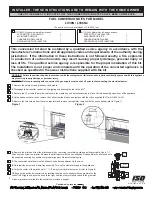
37742-0-1116
Page 5
BEFORE YOU START
Accessories
Most accessories install much more easily before fitting the fireplace
to the opening.
For example, it takes just 10-15 minutes to install the blower through
the back of the unit. Once the fireplace is framed in, it takes up
to an hour.
TrueFlame Technology
This fireplace is equipped with TrueFlame Technology for maximum
flames and ember glow with minimum emissions. The system
includes independently controlled front and rear burners set into a
large ember bed plus a ceramic catalyst and externally adjustable
baffle mounted at the top. Once adjusted by the dealer/technician at
installation, the TrueFlame system requires no scheduled service.
Preparation
This fireplace and its components are safe when installed in
accordance with this Manual. Report any parts damaged in shipment
to your dealer. Do not install the fireplace with damaged, incomplete
or substitute parts.
Installation Considerations
•
Gas supply piping – right side entrance
•
Electrical supply and connections
•
120V, 60Hz, 1 Amp
•
Right side entrance
•
Allowable fireplace mounting surfaces:
•
A flat, hard, combustible or non-combustible surface
•
A raised platform of combustible or non-combustible material.
•
The four corners of the fireplace onto non-combustible material
so that contact is made on all four perimeter edges on the
bottom of the fireplace – such as on cinder blocks
(where allowed by local codes).
•
If the fireplace is installed directly on carpeting, tile or other
combustible material other than wood flooring, it should be
installed on a metal or wood panel extending the full width and
depth of the fireplace.
•
This fireplace is designed to be installed in a zero-clearance
enclosure. Combustible material can come in contact with the
side standoff spacers, and the fireplace can be secured to
combustible framing with the framing brackets provided with
the fireplace.
Planning the installation
First determine where the fireplace will be located and what
accessories will be installed.
Your location must allow for:
•
Venting – either vertical or horizontal. Choose a vent configuration,
(See Pages 28-31)
and make sure the required access through
attics and walls is not blocked by other utilities such as water
lines, sewer vents, gas lines, etc. If access is blocked, you will
need to move the utilities or relocate the fireplace.
•
Gas supply piping (right side entrance) – see pipe size and
specs on
(Page 15)
.
•
Electrical supply requirements
(120V, 60Hz, 1 Amp) (right side entrance)
•
Proper framing required for installation of the fireplace.
See framing dimensions on
(Page 18)
.
•
Finishing the fireplace – drywall thickness, tile or stone
thickness, and the desired decorative accessories can affect
how you frame the opening and how you attach the nailing
flanges to set the proper depth.
(See Page 19)
for finishing
details, before you begin.
Summary of Contents for DVCT36CFP95-1
Page 37: ...37742 0 1116 Page 37 LOG AND EMBER PLACEMENT 1 Place Ember Bed A onto burner pins 3 and 4 ...
Page 38: ...37742 0 1116 Page 38 LOG PLACEMENT 2 Place Log B onto burner pins 1 and 2 ...
Page 43: ...37742 0 1116 Page 43 LOG PLACEMENT 7 Place Log E onto burner pin 5 and the pin on Ember Bed A ...
Page 55: ...37742 0 1116 Page 55 THIS PAGE IS INTENTIALLY LEFT BLANK ...






































